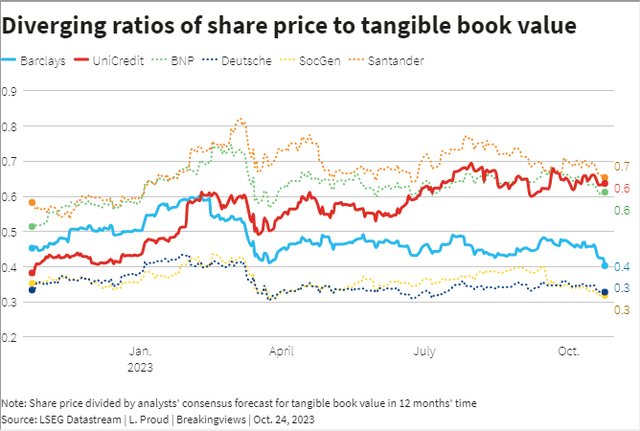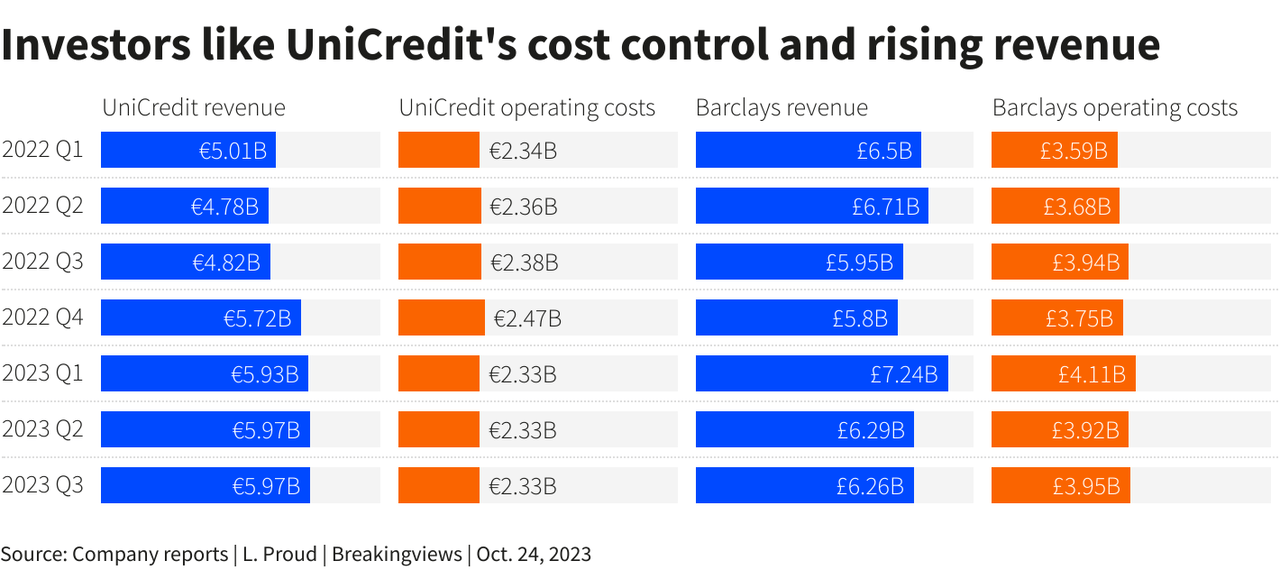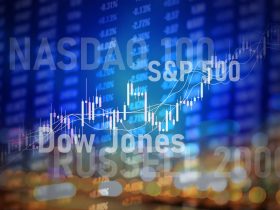By Breakingviews
UniCredit (OTCPK:UNCRY)(OTCPK:UNCFF) and Barclays (BCS) have very little in common aside from a shared history as two of the lowest-valued European lenders. Along with Deutsche Bank (DB) and Société Générale (OTCPK:SCGLY), they’ve often traded at half or less of tangible net asset value.
This year, however, the Italian group led by Andrea Orcel has extracted itself from that ignominious valuation bucket, leaving Barclays behind. UniCredit trades at roughly 60% of forecast tangible book compared with the UK bank’s 40%. For Barclays boss C.S. Venkatakrishnan, there’s only a tiny sliver of hope to be found in the path charted by its surging peer.

The decisive factor behind UniCredit’s rise is that investors now expect it to be far more profitable than they did a year ago. In October 2022, the average analyst forecast implied that Orcel would not quite manage a 7% return on tangible equity over the ensuing 12 months, according to Breakingviews calculations using LSEG Datastream figures. Now, they’re projecting a 12% return for the next 12 months. The equivalent figures for Barclays have gone from implying a roughly 9% return a year ago to just under 10% now – a much smaller rise.
There are a few potentially copiable aspects to UniCredit’s performance, which might suggest that Venkat too could lift his bank’s valuation with the right moves. Orcel’s quarterly operating costs have stayed relatively steady even as his bank’s top line has surged because of rising rates. Barclays investors, however, have at times watched expenses creep up while revenue wobbled up and down. Clamping down on costs, therefore, seems like the right move. Venkat gets it: he announced alongside third quarter results on Thursday that Barclays would evaluate how to “reduce structural costs”.
But slashing expenses won’t solve the bank’s top-line problems. The group said on Thursday that its net interest margin in the domestic UK business will be lower than it previously expected, partly because of an increasingly competitive savings market, which forces banks to pay more interest to depositors. UniCredit doesn’t have that problem. Orcel on Thursday raised his forecast for net interest income this year. The bank is having to pass through less of the rate-hike gain to customers than it thought it would, according to a person familiar with the matter.
One explanation for the difference is that Italian savings rates have historically been higher than in Britain, meaning that depositors in the southern European country kept more of their excess cash in government bonds even before rates started rising. In the United Kingdom, however, persistent low rates saw excess deposits build up in normal bank accounts – money which is now moving around in search of higher returns.
Another problem for Venkat is that his giant trading and investment banking businesses are more volatile than steadier retail and corporate banking, meaning investors tend to assign Barclays a lower valuation multiple. UniCredit shows that it’s possible for an unloved European bank to win investors around. But Barclays may struggle to do the same.

Context News
Barclays on Oct. 24 said that its net interest margin in the domestic UK retail-banking business would be between 3.05% and 3.1% in 2023, compared with its previous target of around 3.15%. The net interest margin, or NIM, measures revenue from lending after deducting the cost of deposits and other liabilities, divided by total interest-earnings assets. The company’s shares fell by 4.7% to just over 137 pence as of 0918 GMT on Oct. 24. UniCredit said on the same day that its net interest income would be greater than 13.7 billion euros in 2023, compared with a previous target of 13.2 billion euros. The Italian bank’s share price fell by 1.2% to just over 22 euros as of 0918 GMT on Oct. 24.
Original Post
Editor’s Note: The summary bullets for this article were chosen by Seeking Alpha editors.
Editor’s Note: This article discusses one or more securities that do not trade on a major U.S. exchange. Please be aware of the risks associated with these stocks.
Read the full article here












Leave a Reply